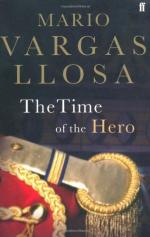|
This section contains 315 words (approx. 1 page at 400 words per page) |

|
The Time of the Hero Summary & Study Guide Description
The Time of the Hero Summary & Study Guide includes comprehensive information and analysis to help you understand the book. This study guide contains the following sections:
This detailed literature summary also contains Bibliography on The Time of the Hero by Mario Vargas Llosa.
One of the greatest Latin American novelists of the twentieth century, Mario Vargas Llosa belongs to a group of writers who brought Latin American fiction out of the regionalist doldrums of the nineteenth century to the attention of the world. This group includes Jorge Luis Borges, Gabriel García Márquez, Julio Cortazar, and Carlos Fuentes. Vargas Llosa, sometimes referred to as the national conscience of Peru, has made a career out of adapting personal and historical events, without bothering about accuracy, to the novel using highly sophisticated techniques of nonlinearity and multiple viewpoint.
His first novel, winner of the Premio Biblioteca Breve (1962) and Premio de la Critica Espanola (1963), La ciudad y los perros (literally "the city and the dogs" but published in English as The Time of the Hero) made use of his own experience at the Leoncio Prado Academy. The novel was so accurate in its portraiture of the academy that the academy's authorities burned 1000 copies and condemned the book as a plan by Ecuador to denigrate Peru. Such a reception guaranteed the book's sales but its content made it the greatest Latin American novel of adolescence: It is the story of young Peruvian males in their transition to manhood.
The Time of the Hero tells a tale of murder: a squealing cadet must be silenced by a gang called The Circle. The reasons given by The Circle, as well as the rationalization of the authorities to excuse the death as an accident, reveal the process of forming boys into men in a world dominated by the military. The academy does not teach fundamentals; it teaches boys how to exist in hierarchical commandstructures and to never, ever squeal. The main characters suffer through a military academy but minor characters portray a non-military route. Although a microcosm of Peruvian society, the novel's themes are universal: masculinity, secrecy, and the military.
Read more from the Study Guide
|
This section contains 315 words (approx. 1 page at 400 words per page) |

|



